Related Research Articles
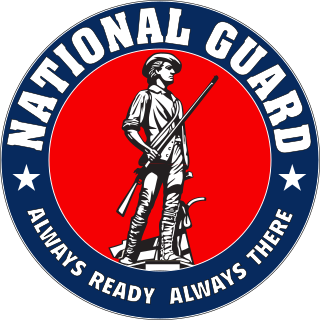
The National Guard is a state-based military force that becomes part of the U.S. military's reserve components of the U.S. Army and the U.S. Air Force when activated for federal missions. It is a military reserve force composed of National Guard military members or units of each state and the territories of Guam, the Virgin Islands, Puerto Rico, and the District of Columbia, for a total of 54 separate organizations. It is officially created under Congress's Article 1 Section 8 ability to "raise and support armies". All members of the National Guard are also members of the organized militia of the United States as defined by 10 U.S.C. § 246. National Guard units are under the dual control of state governments and the federal government.
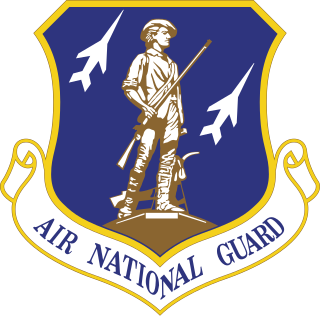
The Air National Guard (ANG), also known as the Air Guard, is a federal military reserve force of the United States Air Force, as well as the air militia of each U.S. state, the District of Columbia, the Commonwealth of Puerto Rico, and the territories of Guam and the U.S. Virgin Islands. It, along with the Army National Guard component of each state, district, commonwealth or territory, makes up the National Guard of each region as applicable.

A Reserve Good Conduct Medal refers to any one of the five military conduct awards, four of which are currently issued and one of which was previously issued, by the United States Armed Forces to members of the Reserve and National Guard. The primary difference between the regular Good Conduct Medal and the Reserve Good Conduct Medal is that the regular Good Conduct Medal is only issued for active duty service while the reserve equivalent is bestowed for reserve duties such as drills, annual training, and additional active duty for either training or operational support to the active duty force or, in the case of the Army National Guard and Air National Guard, in support of Title 32 U.S.C. state active duty (SAD) such as disaster response and relief.

The Texas Air National Guard (TX ANG) is the aerial militia of the State of Texas, United States of America. It is, along with the Texas Army National Guard, an element of the Texas National Guard. No element of the Texas Air National Guard is under United States Air Force command. They are under the jurisdiction of the Governor of Texas through the office of the Texas Adjutant General unless they are federalized by order of the President of the United States. The Texas Air National Guard is headquartered at Camp Mabry, Austin, and its chief of staff is Brigadier General Matthew Barker.

The United States Army Reserve (USAR) is a reserve force of the United States Army. Together, the Army Reserve and the Army National Guard constitute the Army element of the reserve components of the United States Armed Forces.

The Air Force Reserve Command (AFRC) is a major command (MAJCOM) of the United States Air Force, with its headquarters at Robins Air Force Base, Georgia. It is the federal Air Reserve Component (ARC) of the U.S. Air Force, consisting of commissioned officers and enlisted airmen. Together, the Air Force Reserve and the Air National Guard constitute the Air Force element of the reserve components of the United States Armed Forces. AFRC also plays an integral role in the day-to-day Air Force mission and is not strictly a force held in reserve for possible war or contingency operations. AFRC also supports the United States Space Force through the 310th Space Wing, pending the creation of a space reserve component.

The United States Navy Reserve (USNR), known as the United States Naval Reserve from 1915 to 2005, is the Reserve Component (RC) of the United States Navy. Members of the Navy Reserve, called Reservists, are categorized as being in either the Selected Reserve (SELRES), the Training and Administration of the Reserve (TAR), the Individual Ready Reserve (IRR), or the Retired Reserve.
The Palace Chase program allows active duty officers and airmen to voluntarily transfer from active duty in the United States Air Force (USAF) to the United States Air Force Reserve (USAFR) or the Air National Guard (ANG).

A military reserve force is a military organization whose members (reservists) have military and civilian occupations. They are not normally kept under arms, and their main role is to be available when their military requires additional manpower. Reserve forces are generally considered part of a permanent standing body of armed forces, and allow a nation to reduce its peacetime military expenditures and maintain a force prepared for war. During peacetime, reservists typically serve part-time alongside a civilian job, although most reserve forces have a significant permanent full-time component as well. Reservists may be deployed for weeks or months-long missions during peacetime to support specific operations. During wartime, reservists may be kept in service for months or years at a time, although typically not for as long as active duty soldiers.
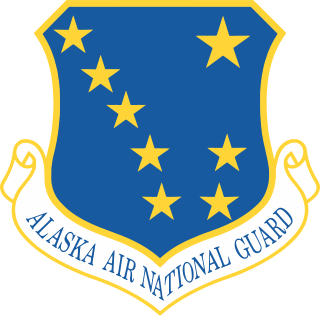
The Alaska Air National Guard (AK ANG) is the aerial militia of the State of Alaska, United States of America. It is, along with the Alaska Army National Guard, an element of the Alaska National Guard.

The Tennessee Air National Guard is the aerial militia of the State of Tennessee, United States of America. It is, along with the Tennessee Army National Guard, an element of the Tennessee National Guard.
The Active Guard and Reserve (AGR) is a United States Army and United States Air Force federal military program which places Army National Guard and Army Reserve soldiers and Air National Guard and Air Force Reserve airmen on federal active duty status under Title 10 U.S.C., or full-time National Guard duty under Title 32 U.S.C. 502(f) for a period of 180 consecutive days or greater in order to provide full-time support to National Guard and Reserve organizations for the purpose of leading, organizing, administering, recruiting, instructing, or training the Reserve Components according to Subsection 101(d)(6). AGR personnel may also be assigned to active duty roles in support of Regular Army and Regular Air Force organizations or joint organizations such as the Office of the Secretary of Defense, Secretary of the Army, Secretary of the Air Force, the Joint Staff, or the Unified Combatant Commands.

The 482nd Fighter Wing is an Air Reserve Component (ARC) unit of the United States Air Force. It is assigned to the Tenth Air Force, Air Force Reserve Command (AFRC), stationed at Homestead Air Reserve Base, Florida. If mobilized to active duty, the 482 FW is operationally gained by the Air Combat Command (ACC).

The 156th Wing is a unit of the Puerto Rico Air National Guard, stationed at Muñiz Air National Guard Base, in Carolina, Puerto Rico. If activated to federal service with the United States Air Force, the wing is operationally gained by the Air Mobility Command (AMC). It traces its history to the creation of the 156th Tactical Fighter Group in 1962.

The 169th Fighter Wing is a unit of the South Carolina Air National Guard, stationed at McEntire Joint National Guard Base, Columbia, South Carolina. If activated to federal service, the Wing is gained by the United States Air Force Air Combat Command.
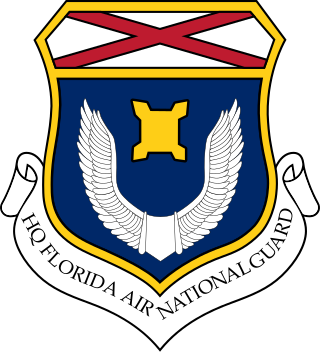
The Florida Air National Guard is the aerial militia of the State of Florida. It is, along with the Florida Army National Guard, an element of the Florida National Guard. It is also an element of the Air National Guard (ANG) at the national level, falling in with the Army National Guard (ARNG) as part of the greater United States National Guard under the National Guard Bureau (NGB).
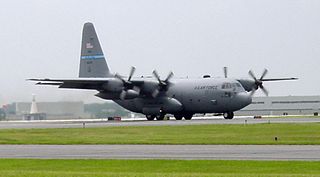
New Castle National Guard Base is a United States Air Force installation under the control of the Delaware Air National Guard, located at Wilmington Airport in New Castle County, Delaware.

The Air Reserve Personnel Center manages personnel records for the Air National Guard and Air Force Reserve and it is located at Buckley Space Force Base in Aurora, Colorado. It maintains the virtual Personnel Center, a Web-based portal for Airmen to perform personnel services transactions.

Pittsburgh IAP Air Reserve Station is a United States Air Force base, located at Pittsburgh International Airport, Pennsylvania. It is located 12.1 miles (19.5 km) west-northwest of Pittsburgh, Pennsylvania.
The reserve components of the United States Armed Forces are military organizations whose members generally perform a minimum of 39 days of military duty per year and who augment the active duty military when necessary. The reserve components are also referred to collectively as the National Guard and Reserve.
References
- ↑ "Full-Time Air Reserve Technicians".
- ↑ "Archived copy" (PDF). Archived from the original (PDF) on 2012-04-01. Retrieved 2011-10-11.
{{cite web}}: CS1 maint: archived copy as title (link) - ↑ "General Information for Air Reserve Technician (ART) Positions" (PDF). afciviliancareers.com. Retrieved 4 May 2023.
- ↑ "Air Force Reserve: Reserve Categories". Afreserve.com. Retrieved 2011-10-11.
- 1 2 Air Force Reserve: Reserve Categories. Afreserve.com. Retrieved on 2013-07-23.